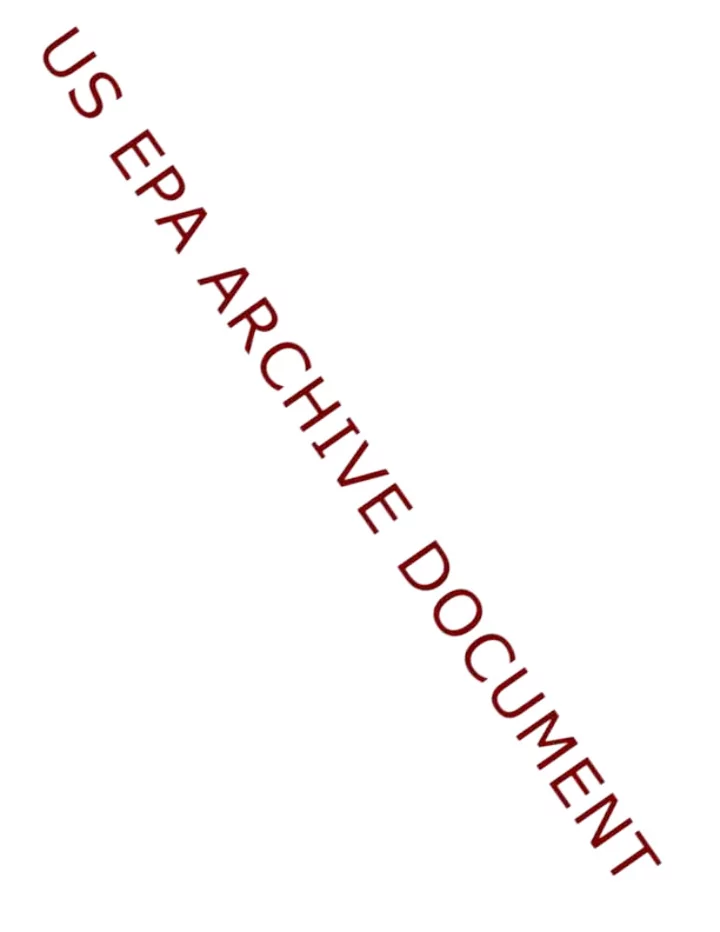

U.S. EPA Design for the U.S. EPA Design for the Environment Program Environment Program February 3, 2009 Clive Davies, U.S. EPA
Presentation Outline Presentation Outline • Overview – Priorities – Operating principles • Safer Product Labeling Program – Product review – Criteria • Developing Transparent Criteria 2
Overview of DfE Program Overview of DfE Program Focus • Chemicals of concern • Informed Substitution • OPPT technical tools and expertise • Considerations • Business client • Multi-stakeholder participation • Business realities • Potential benefits for industry and the • environment Results • Partners reduced more than 335 million pounds of chemicals of • concern last year 3
DfE: Informing Substitution to DfE: Informing Substitution to Safer Chemicals Safer Chemicals • Alternatives Assessments Flame Retardants – • Furniture Foam • Printed Circuit Boards Lead-Free Solder – • Auto Refinishing Best Practices • DfE Safer Product Labeling Program Product Recognition – Safer Ingredients (CleanGredients TM database) – • Safer Detergents Stewardship Initiative (SDSI) 4
DfE Safer Product Labeling DfE Safer Product Labeling • Hazard Focus • Continuous Improvement Driven by Green Chemistry – – As Innovation Occurs Continuum of Improvement Continua May Shift Acknowledges Business Formula Ingredient by Functional Class – Realities Sustainable Improved Of Concern Characteristics Characteristics Characteristics of Improved of Sustainable of Ingredient Ingredient Ingredient of Concern 5
DfE Safer Product Labeling Program DfE Safer Product Labeling Program Steps to Partnership – From the Formulator’s point of view Steps to Partnership – From the Formulator’s point of view 1. Contact EPA DfE to discuss product submissions. 2. Request 3 rd -party ingredient profiling. 3 rd 3. party Submit ingredient profiles to EPA DfE. 4. Review ingredient profiles – EPA technical workgroup. 5. Post-assessment discussion with submitter. 6. Sign partnership agreement. − 3-year agreement between formulator and EPA 6
DfE Review – 3 Basic Components DfE Review – 3 Basic Components 1) Review every ingredient by functional use class • To promote green chemistry • To understand toxicity - Literature - Analogous chemicals – SAR 2) Review formulation as a whole • Synergistic effects • pH • Performance testing 3) Partnership Agreement 7
Data in DfE Data in DfE • Sources Literature Search – Data from internal sources – • PMN submissions • TSCA Section 8(e) • RED documents Data from manufacturers – • Preferences Measured data – Estimated data – Authoritative lists – 8
DfE Screens for Safer Chemicals DfE Screens for Safer Chemicals • Overarching “General Screen” Environmental and Human Health Endpoints – Can be refined for “functional use” component classes – • Endpoints with thresholds corresponding to New Chemicals Program criteria for low concern Acute mammalian toxicity – Carcinogenicity – Environmental toxicity and fate – Genetic toxicity – Neurotoxicity – Repeated dose toxicity – Reproductive and developmental toxicity – Respiratory sensitization – Skin sensitization – 9
DfE General Screen: DfE General Screen: Thresholds for acceptable chemicals - Examples Thresholds for acceptable chemicals - Examples Carcinogenicity Listed on IARC, NTP, EPA, or EU CMR – • Carcinogenic in humans • Probably carcinogenic to humans • Possibly carcinogenic to humans Chemicals not listed – • Consider data and apply GHS criteria • Evaluate structural activity relationships (SAR) and run OncoLogic™ (If no measured data) Acute Mammalian Toxicity Criteria – Route of Exposure Median Lethal Dose Oral LD50 >2000 (mg/kg) Dermal LD50 >2000 (mg/kg) Inhalation LC50 (gas) >5000 (ppm) Inhalation LC50 (vapor) >20 (mg/L) Inhalation LC50 (dust/mist) >5 (mg/L) SAR and application of GHS (If no measured data) – 10
DfE General Screen: DfE General Screen: Thresholds for acceptable chemicals - Examples Thresholds for acceptable chemicals - Examples Environmental Fate and Toxicity Acute Aquatic Toxicity Persistence (Measured in terms of Bioaccumulation Value (L/E/IC50)1,2 rate of biodegradation) Potential If ≤ 1 ppm… …then may be acceptable if biodegradation occurs within a 10 day window … If >1 ppm and ≤ 10 ppm… …then biodegradation must occur within a 10-day window… If >10 ppm and <100 …then biodegradation must occur …and BCF <1000 ppm… within 28 days without products of concern … If ≥ 100 ppm… …then biodegradation need not occur within 28 days if there are no products of concern and half-life <180 days… 11
Building a Transparent Screen Building a Transparent Screen Objective: For a given “functional use” component class: Differentiate chemicals at the safer end of the environmental and human health continuum • Convene a multi-stakeholder group (with NGOs) • Establish the scope of the functional use class • Develop list of representative chemicals for the class – across the continuum • Human health and environmental data • Efficacy information • Information evaluated by EPA and presented to all stakeholders • Proprietary information is protected • Environmental and human health data is displayed in a user-friendly format • Establish key distinguishing endpoints & thresholds to differentiate safer ingredients 12
Contact Information Contact Information Clive Davies davies.clive@epa.gov 202-564-3821 http://www.epa.gov/dfe 13
Recommend
More recommend